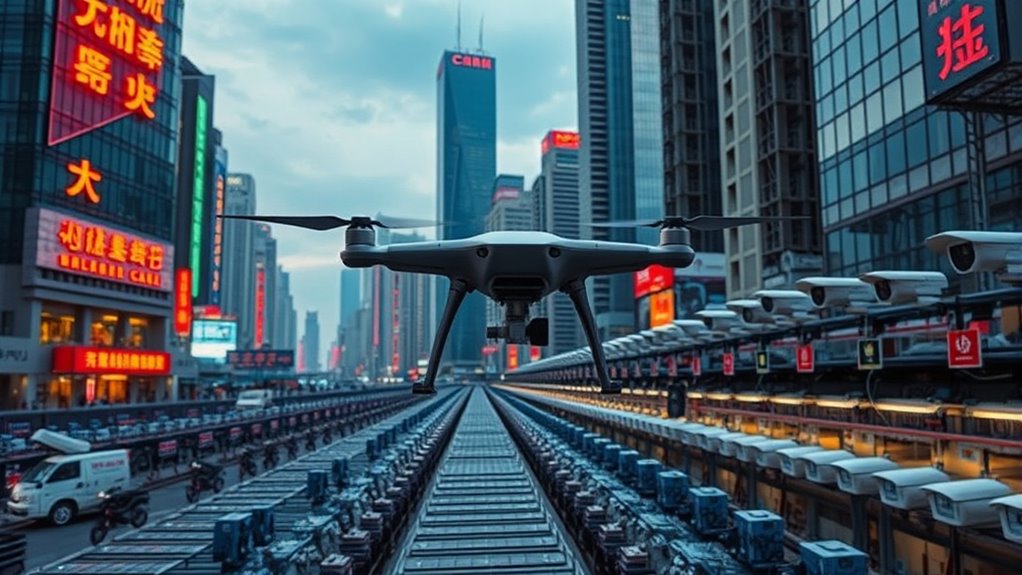China’s techno-nationalism combines state-led efforts and strategic policies to dominate key industries like AI, telecommunications, and semiconductors. The government promotes self-reliance by actively acquiring foreign technology through legal channels and espionage, fast-tracking innovation and integration. They build resilient ecosystems that foster rapid development, often prioritizing mass deployment over Western patent protections. If you keep exploring, you’ll discover how this approach shapes global tech rivalries and China’s futuristic ambitions.
Key Takeaways
- China emphasizes self-reliance and strategic government-led ecosystems to dominate key industries like AI and semiconductors.
- It employs both legal policies and clandestine espionage to acquire foreign technology rapidly.
- The country leverages intellectual property to shape innovation policies and fill technological gaps.
- Initiatives like “Made in China 2025” aim to develop indigenous tech and reduce dependence on foreign firms.
- China balances legal IP management with covert operations, boosting its global technological influence and capabilities.

China’s rise as a technological powerhouse is driven by a strategic blend of innovation and nationalism that emphasizes self-reliance and state-led development. This approach fuels the country’s push to dominate key industries like AI, telecommunications, and semiconductor manufacturing. Central to this effort is the management of intellectual property, which plays a vital role in shaping China’s innovation ecosystems. Unlike Western norms that prioritize protections for inventors, China often treats intellectual property as a tool to accelerate national progress. While this has led to concerns about IP theft and infringement, it also enables the government to swiftly adapt and integrate foreign technologies into its domestic markets. By fostering close collaborations between state agencies, universities, and private firms, China creates innovation ecosystems that are tightly controlled and highly strategic. These ecosystems prioritize rapid development and mass deployment, often bypassing traditional Western standards of patent enforcement. Additionally, the government’s strategic use of intellectual property as a means of national advancement underscores its role in shaping innovation policies. This multifaceted approach allows China to leverage both legal and clandestine methods to enhance its technological capabilities.
You’ll notice that the Chinese government actively encourages the acquisition and utilization of foreign technology, sometimes through aggressive means like espionage. While official policies promote innovation through legal channels, intelligence operations are often deployed to gain competitive advantages secretly. This dual approach helps China fill gaps in its technological capabilities and leapfrog ahead of competitors. It’s not just about copying; it’s about learning, adapting, and then innovating on a larger scale. The government’s focus on self-reliance is evident in initiatives like “Made in China 2025,” which aims to develop indigenous technologies and reduce dependence on foreign suppliers. This strategy underscores the importance of building robust innovation ecosystems that are resilient to external pressures and intellectual property disputes. Additionally, the integration of state-led development models ensures that technological progress aligns with national strategic goals. Such models facilitate the consolidation of resources and streamline decision-making processes to accelerate growth. The emphasis on strategic technology transfer also enables China to rapidly assimilate foreign innovations into its domestic industries. Moreover, fostering domestic innovation is a key aspect of China’s long-term vision for technological independence and global influence.
Frequently Asked Questions
How Does China Balance Innovation With Intellectual Property Concerns?
You might wonder how China balances innovation with intellectual property concerns. They often prioritize rapid innovation to boost economic growth while trying to strengthen intellectual property protections through legal reforms. However, the innovation balance can be tricky, as enforcement varies and some fear widespread infringement. To succeed, China needs to improve IP enforcement, foster fair competition, and encourage genuine innovation, ensuring both progress and respect for intellectual property rights.
What Role Do Private Companies Play in China’S Techno-Nationalist Strategies?
You see that private companies in China play a vital role in its techno-nationalist strategies by working closely with the government. They often align their innovations with national goals, benefiting from government support and collaboration. This partnership accelerates technological development, while also ensuring that private sector growth contributes to China’s broader strategic interests, blending market-driven progress with state-led objectives to maintain competitiveness and control in key technological sectors.
How Does China’S Approach Compare With Other Countries’ National Security Policies?
Ever wonder how China’s approach stacks up against other nations’ security policies? You’ll see that China emphasizes sovereignty assertions, prioritizing control over data and technology, while often limiting foreign collaboration to protect national interests. Unlike countries that promote open innovation, China’s strategy is more state-driven, blending innovation with espionage to safeguard its tech advancements. This contrast highlights differing visions of security, sovereignty, and international cooperation.
What Are the Long-Term Global Economic Impacts of China’S Techno-Nationalism?
You’ll see long-term global economic shifts as China pushes for greater technological sovereignty, which can disrupt supply chains and competition. This may lead to increased innovation but also create barriers for international trade and collaboration. As China invests heavily in its tech sector, other nations might respond with protective policies, ultimately reshaping the global economy’s landscape and influencing how countries balance cooperation and rivalry in tech development.
How Effective Are China’S Espionage Efforts in Acquiring Foreign Technological Secrets?
Imagine a shadowy figure slipping through a dark alley—this is how China’s cyber espionage often operates. Their covert operations are surprisingly effective, enabling them to acquire foreign technological secrets with precision. While not foolproof, these efforts give China a strategic edge, fueling innovation and state-driven progress. You can see their espionage as a calculated dance, blending technology and secrecy to outpace competitors quietly but decisively.
Conclusion
You now see how China’s techno-nationalism is a double-edged sword—fueling innovation while lurking behind curtains of espionage. It’s like a wildfire, blazing with promise but risking uncontrollable damage. As you watch this landscape shift, remember that understanding these forces helps you navigate a future where technology isn’t just a tool, but a battleground. Staying informed is your shield in this ever-changing world of innovation and intrigue.









